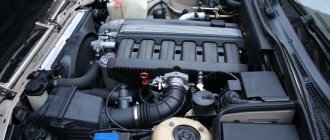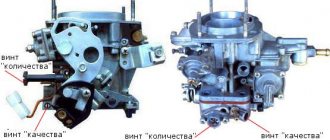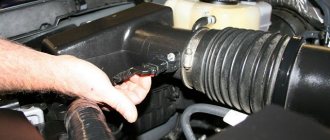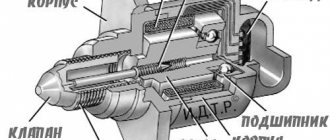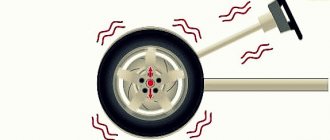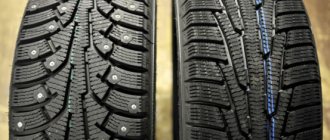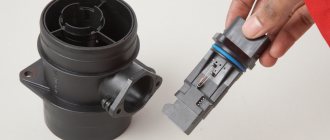Where does this come from?
Vibration is a consequence of the action of centrifugal forces - a certain imbalance between the rotating components of the car - for example, between the engine flywheel and the crankshaft, a heater or radiator fan, drums and brake discs, a large difference in mass between the engine connecting rods and the piston system.
But what can cause car vibration or, in other words, imbalance?
There are several of them:
- Technological reasons. They are most often caused by various deviations in the parameters and dimensions of parts.
- Design reasons are caused by the characteristics of a particular part. For example, on each of the wheels of a car there is a valve, which creates (albeit insignificant) deflection.
- Operational reasons are most often caused by severe deformation or wear of parts.
Damage to the internal parts of the hinge, which caused vibration, and this in turn led to the rupture of the engine mount.
Balancing - as a way to eliminate vibration
Of course, balancing does not always eliminate shaking in the cabin, but sometimes these measures can reduce vibrations to a minimum. This is done by balancing the “problem” part.
To begin with, the heaviest side is found and the lighter side is weighted. If everything is done correctly, vibration is eliminated.
In this case, the balancing process itself is often carried out in several main ways:
- Dynamic method . Effective for eliminating vibration in almost any part. Its peculiarity is the forced rotation of the part using special equipment.
- Static method . Does not imply forced rotation. It is also simpler in that it does not require the use of expensive equipment - all the work can be done in a garage. Disadvantages include a limited selection of parts that can be tested and low accuracy.
If you choose from the two options proposed above, then the dynamic method looks more preferable, because it is more universal and all the necessary parameters can be seen on the computer.
In the static method, all work is carried out exclusively experimentally - drilling, attaching additional weights, removing excess material, and so on.
Other causes of vibrations
Low tire pressure: Insufficient tire pressure can cause vibrations. In addition, low pressure leads to premature, uneven tire wear and ultimately to tire rupture.
Solution: First of all, you need to make sure that the tires are properly inflated. Perhaps this is precisely the point. It is advisable to always have a quality tire pressure gauge in your glove compartment and regularly check the air pressure in your tires to ensure they last as long as possible.
Uneven tire wear: If the wheel alignment is incorrect (due to road unevenness), the tires wear unevenly. The tread may wear off on one side or the tire may buckle, causing the tread to become grooved. Over time, vibrations occur and road noise can be heard when accelerating.
Solution: Have your tires checked for uneven wear by a mechanic. It may be necessary to adjust the wheel alignment or even replace the tires if they are worn excessively.
Tire defect: In fact, tires can have various defects. They may lose their round shape, and the tread or carcass cord may peel off around the circumference. Such problems usually appear when driving at low speeds (25-30 km/h). These may be manufacturing defects, but most often this happens due to driving on poorly paved roads. A damaged tire may have cracks, cuts, or bulges in the sidewall or tread.
Solution: A qualified mechanic can help resolve this issue. If it is a manufacturing defect, the warranty may cover the full cost of replacing the defective tires.
Worn out tread: Tires have minimal or no tread left. Not only do such tires have poor grip, poor braking performance and lateral slip resistance, but they also slide uncontrollably on wet or snowy roads. And the appearance of vibrations once again reminds us that it is high time to solve the problem that has arisen.
Solution: Buy new tires without delay.
Damaged rims
Sometimes the problem is not the tires, but what they are mounted on. If the wheels hit large or deep potholes or if they hit a low curb, the rims may become deformed. A severe impact to the wheel damages both the tire and the wheel. Even if the wheel has no visible damage, this does not mean that the balancing is not impaired. Vibrations can be transmitted through the steering wheel or the car body, depending on which wheel is damaged.
Solution: Have your rims checked by a car repair shop. If there is no damage, balancing will be enough to solve the problem. If the disk is bent, you can try to repair it in a specialized workshop. If the wheel rim cannot be repaired, it will have to be replaced.
Snow accumulation and ice formation
If your vehicle is driven in harsh winter conditions, vibrations, especially during or after snowfall, may be due to ice forming on the wheels. When driving a car in such conditions, snow, ice and liquid dirt accumulate in and around the wheels, which, if frozen, provoke an imbalance in the wheels and tires, which, accordingly, leads to vibration.
Solution: if you do not have the opportunity to park your car in a room with an air temperature above 0, you need to go to a car wash to wash off the frozen dirt. This should solve the problem, at least until the next snowfall.
See also:
Why the steering wheel turns hard: the main reasons
When should a car enthusiast be concerned about vibration levels?
By the way, it is not always clear when it is necessary to take some measures and go to a service station. Vibration is present in most cars. But how to determine which level is acceptable and which is not?
Again, the car enthusiast does not have any special instruments at hand to determine vibration, so he has to proceed from his own feelings.
Initial parameters for checking for shaking: the car is stationary, the gearshift knob is in neutral, the clutch is engaged, and the gas is added very smoothly.
Essentially, the vibration of the car at idle is checked. Is everything done? –
It is necessary to fix the problem if:
- when objects lying on the dashboard begin to move spontaneously and fall to the floor;
- a strong vibration is clearly felt on the steering wheel even with a light touch;
- The image in the rearview mirror is very difficult to catch - it becomes blurred due to strong rattling.
How to identify the source of vibration
Determining the source of vibration is a very difficult issue. To begin with, a car enthusiast must understand when vibration occurs - in a moving or stationary car.
In addition, it is necessary to analyze when the vibration appeared. Perhaps repair work was only recently carried out at a service station, or this phenomenon was noticeable from the very first days of purchasing the car.
The first thing you should pay attention to is engine performance. Vibration in the cabin is often felt precisely because of incorrect settings of the “heart” of the car.
To analyze this moment, it is necessary to observe the operation of the engine at idle - how “smoothly” it runs, whether there are periodic “fall asleep” and “bursts”.
To make the check more effective, you can call a friend to help you. In this case, one will observe the vibration in the cabin, and the second will carefully inspect the engine compartment.
Shaking appears when accelerating
The most dangerous and unpleasant situations are those when a noticeable vibration manifests itself precisely at the moment of gradually picking up speed.
In some cases, the car shakes only at certain speeds or when reaching high speeds. That is, at low speed everything is good and stable. As soon as the revs reach a high level, the car literally wobbles. If you encounter similar moments, watch the speed first. She may be:
Shaking at high speed may be due to a banal feature of the suspension. Some cars are simply not adapted to driving at such speeds, which is why when reaching certain values, shaking begins in different directions.
But if the speed is low or medium, and similar symptoms appear during acceleration, this is much worse.
There is a high probability that a malfunction has occurred. They need to be found. If the shaking is relatively mild at the moment, then over time the vibrations can intensify, which will sometimes lead to unpredictable and unexpected negative consequences.
When it comes to shaking during acceleration, the first things you need to check are:
From the above, it can be noted that shaking of cars with automatic transmissions during acceleration is usually associated with the oil in the box or with the filter. For mechanics, the problem with the cardan is more relevant.
Safety precautions when detecting vibration
When identifying the source of increased vibration, you must always remember the possible danger. To avoid burns and injuries, you must follow these recommendations:
- firstly, when probing the most suspicious areas, it is advisable not to touch very hot areas, otherwise a severe burn is inevitable;
- secondly, when hanging a car, it is advisable to place it on reliable supports;
- thirdly, if testing is carried out on roads with a flow of other cars, it is necessary to act in such a way as not to disturb anyone.
How to search for a vibration location
To be more likely to find the source of vehicle vibration, you must proceed in the following sequence:
- First , inspect the engine, exhaust system, and suspension with it turned off and then on.
- It happens that the engine protection is installed in close proximity to the unit itself and touches it. Such contact often produces strong vibration;
- Secondly , it is necessary to check the threaded connections, as well as the quality of drawing of all screws. It happens that only this work is enough to eliminate vibration;
- Thirdly , you need to turn off the fan. This will eliminate it from the list of possible “culprits” of vibration. If this particular unit is faulty, it can always be replaced;
- Fourth , depress the clutch and put the gearshift knob in neutral. If the problem persists, then one of the reasons may be the clutch basket, flywheel, crankshaft or automatic transmission parts.
There are situations when vibration occurs only during movement. In this case, problems with the chassis or transmission may be the cause.
Also, the cause of vibration in the steering wheel may be incorrect wheel alignment. Check whether the latest ones are installed correctly on the car.
If vibration occurs only when braking, then the likely cause is drums, discs or hubs.
In a situation where the car shakes even at low speed, wheel imbalance may occur. To verify your assumptions, you can swap the wheels.
The cardan can also act as a source of vibration, but here the vibration frequency is much higher than in the case of drums or disks.
The search for the cause of car vibration should be carried out both in a static position of the car and in motion. At the same time, we must not forget about checking the quality of vibration isolators.
Often, replacing them is enough to solve the problem. In practice, even the appearance of a crack, hardening or aging can lead to vibrations.
Vibration at idle
Vibrations are the rattling sounds produced by the engine and felt by the driver when he holds the steering wheel.
If there are problems with the engine, the rattling from barely perceptible becomes very strong and unpleasant.
Signs
The main symptoms of this problem include:
- increased vibration of the steering wheel, which can be transmitted to the engine body;
- engine popping;
- engine jerks and failures;
- The tachometer readings exceed the permissible values for the car.
It will also be useful for you to know why the car shakes during acceleration and at high speed.
Causes
The main causes of engine vibrations include:
- engine tripping (uneven operation of the pistons or failure of one of them);
- incorrect motor mounting;
- faulty engine mounts;
- the crankshaft is unbalanced;
- the fuel system is dirty;
- improper fastening of other units;
- ignition system malfunction.
- One of the common mistakes associated with engine mounts is installing mounts from different materials.
The above reasons are valid for gasoline cars.
The reasons why the vibrations of a diesel engine have increased, due to the difference in design and operation from a gasoline engine, are slightly different:
- malfunction of the cylinder-piston group or gas distribution mechanism as a whole or in a separate cylinder;
- compression variation in cylinders;
- malfunction of the high pressure fuel pump, diesel injectors or timing belt teeth;
- incorrect injection advance angle.
Why is low engine idle dangerous?
No less a problem is reducing idle speed.
Low speeds can lead to the following consequences:
- fuel detonation in the cylinders does not occur completely;
- oil dilution;
- washing off the lubricant;
- coking of the motor.
It is also worth noting that at low idle speeds the car will stall, as it will not have enough revolutions to maintain operation. This, in turn, will increase the load on the ignition system, increasing wear on the car and reducing its service life.
Diagnostics
To carry out diagnostics, you should pay attention to the following points:
- check the injector/carburetor;
- take readings from the tachometer and pressure sensor and compare them with normal values;
- check the fastening of the motor and other components;
- run computer diagnostics of the car (if there are appropriate electronics on board).
Separately, it is worth mentioning the process of checking engine mounts, since their incorrect installation quite often causes problems, although they are easily diagnosed and corrected.
We recommend: Motor oil labeling
Important! Since visible problems may hide other, more serious ones, if any problems occur, you should contact a car service center.
Checking the airbags is carried out as follows: one person sits behind the wheel, opens the hood and drives back and forth in place, the second person watches the engine at this moment - it should tilt evenly in all directions. If the engine rolls a little more in one direction, then the cushion on that side should be replaced.
What measures to take in case of strong vibration
When faced with strong vibrations, you can begin to combat the problem.
Engine adjustment
Adjusting the motor, first of all, includes checking the fastenings of the parts, as well as their condition. Having ensured that they are in good working order and correctly secured, it is necessary to calibrate their joint work.
The best way to do this is to check the factory settings in the instructions and reset all settings to them. Tuning includes not only tuning the operation of the engine itself, but also related systems - fuel supply, ignition, and so on.
If parts have been replaced, it is necessary to ensure that the parts in weight and material match those that were replaced - otherwise imbalance will occur.
Did you know? If the crankshaft is too heavy, it is lightened by cutting out holes, thereby knocking off the extra grams.
Correct installation of the timing belt
Another important element in solving the problem is installing the timing belt. The belt is responsible for the connection between the crankshaft and the camshaft, and its incorrect installation will inevitably lead to disruption of the gas distribution system.
The belt is replaced as follows:
- the protective belt cover is unscrewed;
- disconnects from the sensor;
- checking the coincidence of the marks on the camshaft gear (or shafts, if there are several of them), the gas distribution mechanism drive, the flywheel, the crankshaft - this will ensure the correct valve timing;
- the old belt is removed;
- a new belt is put on: first on the crankshaft pulley, then on the camshaft gear and pump;
- two revolutions of the crankshaft are carried out, after which the marks are checked - if the belt is installed correctly, they will coincide.

